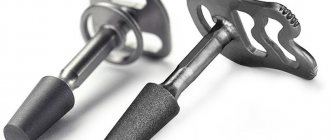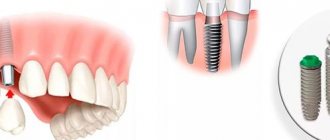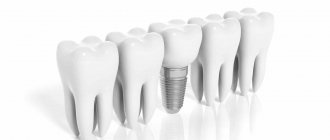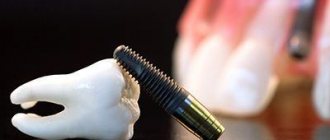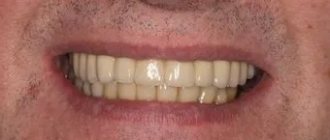The absence of one or more teeth negatively affects not only the functioning of the jaw, but also the gastrointestinal tract. Ignoring missing teeth leads to facial deformation and serious oral pathologies. The person begins to feel embarrassed to smile and talk normally, becoming withdrawn and taciturn.
Modern dentistry offers several types of dental implantation: endosseous (intraosseous), basal, endodonto-endosseous, intramucosal. Among them, basal implantation is the most controversial technology.
Some clinics offer it as a revolutionary breakthrough, allowing you to quickly restore teeth in one go, even with a lack of bone tissue. Others, including our YuliSTOM clinic, consider implantation to be an outdated type of implantation, often rejected by the human body’s immune system. Why are dentists so ambivalent about this method?
New or old technology?
The development of implantation since the 60s of the 20th century has been based on two different technologies. The founder of modern dental implantology, Swedish doctor Per-Ingvar Brånemark, came up with root-shaped implants that were implanted in two stages. The phenomenon of osseointegration, discovered by scientists from Sweden, proved that a titanium rod implanted into bone tissue was able to completely fuse with the bone, becoming motionless, strong, and stable.
American professor Leonard Linkov invented implantation systems similar to blades or thin plates (blades). To implant them, it was necessary to cut out a bed in the basal tissue of the bone, where a plate with a pin was placed. A crown was then placed on it, and the implant itself was integrated into the bones, overgrown with connective tissue.
At that time, basal dental implantation became an ideal option for those patients for whom root-shaped implants were contraindicated due to insufficient bone tissue for their implantation.
Later, basal technology was improved in 1982 by the French scientist Jean-Marc Julier. The scientist proposed an implant in the form of an inverted letter T with a longer root part than that of classical products. It was not installed in the spongy porous tissue of the jaw bone, where the roots of the teeth are located, as with traditional implantation, but in deeper layers - the basal ones.
At his instigation, the method of implanting implantation systems for bone tissue atrophy, if the patient has insufficient volume, began to be actively introduced in dental clinics in Europe. The basal bone is not subject to atrophy and has fewer capillaries. Such characteristics made it possible to carry out dental implantation even with a significant lack of the upper layer of the jaw bone.
However, by the beginning of the 90s, European dental associations agreed that the effectiveness of basal implantation was low. In practice, it turned out that implants implanted in this way served much less than root-shaped ones and could not withstand the chewing load.
However, the collapse of the Iron Curtain between Russia and Europe in the 90s opened the way for ineffective basal implantation in dental clinics in Russia and the CIS countries.
The essence of the basal implantation method
Despite the fact that basal implantation is prohibited in a number of European countries, it is still actively used in Russia. It may be offered under other names: transgingival, compression, one-stage, one-component, single-phase, express implantation, rapid implantation system, minimally invasive (or minimally invasive), implantation with immediate loading. You need to know this so that you don’t accidentally agree to install basal implants under a different name.
Dental implantation using the basal method
Judging by the names of the basal method, it can be understood that the active use of the basal implantation method in a number of clinics is based on the following three pillars:
- unlike classical two-stage implantation, prosthetics are carried out not after 2-6 months, but within one week;
- implants can be implanted in cases of edentia and complete absence of teeth without increasing bone volume;
- there are far fewer medical contraindications for its implementation than with the traditional method.
These three advantages determine the category of patients for whom basal technology is recommended:
- in the absence of more than three teeth or their complete absence;
- in the presence of inflammatory processes in bone tissue, advanced dental diseases of periodontal tissues: periodontitis, periodontal disease, idiopathic diseases with tissue lysis, periodontoma (tumors);
- severe atrophy of soft and hard jaw tissues;
- if you want to urgently restore teeth and it is impossible to carry out the classical protocol;
- if you are allergic to acrylic plastic of removable dentures or have an individual intolerance to them.
The decisive factor for many patients when choosing basal technology is, first of all, its efficiency. Waiting for dental restoration for several months, and sometimes more than a year, scares people away, and they agree to the fastest option.
Few clients of dental clinics pay attention to a very important point in the warranty agreement for the basal method - they do not exceed 12 months. Whereas classic implants, for example, Nobel biocare (USA) or Straumann (Switzerland), are given a lifetime guarantee.
Basal implantation in Moscow. Basal Implantation Institute and Clinics
According to studies on our portal, no more than 10 dentists are engaged in basal implantation in Moscow, while there are no more than three specialized clinics with extensive experience in this method. One of the first in Russia to practice single-phase implantation was the clinics “Simpladent”, “dentalroott”, doctors from the clinics “Smile-at-once” and “Center for Express Implantation”.
Basal implantation promotions and discounts in Moscow clinics! Considering the cost of dental implantation, many patients expect special offers from clinics for treatment. Indeed, when searching for basal implantation clinics, cost is often a primary consideration along with choosing a dentist to perform the treatment.
How is basal implantation performed?
Before performing basal implantation, the dentist examines the patient’s oral cavity and prescribes an orthopantomogram and computed tomogram. This will allow you to evaluate the structure, bone density, and calculate the required distance between the implant installation area and adjacent teeth. Ideally, the surgeon should create a 3D model for accurate implantation, but not all specialists do this.
After a comprehensive examination and test results, dentists carry out, if necessary, sanitation of the oral cavity, treatment of pathologies of teeth and gums. If there are no contraindications, a one-stage basal implant procedure is performed.
Proponents of basal implants argue that their installation is a low-traumatic process for patients. Classical implantation involves extensive drilling of the cancellous bone and the need to open the gums to place a large-diameter implant. With basal implantation, the surgeon must not only peel off the mucosa and periosteum, but also cut into holes deep into the basal layers of the bone. Therefore, the healing process will be extremely painful and will take at least two weeks.
If a specialist has created a 3D model, then special stencil templates, prepared in advance using modeling programs, are placed on the gums. An implant with a permanent abutment is screwed through the holes in the stencils at an angle. This process is carried out even immediately after tooth extraction.
Basal implants are a one-component, non-separable titanium root system with a periosteal abutment. Their installation takes only 20-30 minutes and is carried out under local anesthesia. After 3-4 days, the surgeon begins the prosthetic stage, putting on a permanent crown with a load instead of a temporary one. Thus, dental restoration is completed in one week. And this is the main decisive point for some patients who do not want to wait for the long-term implantation of a classic implant for many months and undergo bone grafting.
Types of implants for the basal method
What is your dentist hiding from you?
After reading beautiful advertisements, some patients sit in the dentist’s chair without thoroughly understanding the method and experience of the specialists! During a face-to-face consultation with an implantologist, it is quite difficult for an ordinary person to make a decision - to trust the dentist or not? An experienced dentist will tell you both the pros and cons of each method used. However, some doctors miss some possible complications that may occur after undergoing treatment. Especially if there is not enough experience with total prosthetics of both jaws!
When choosing a clinic and doctor for basal implantation, pay attention to the dentist’s experience in total dental restoration! When performing basal implantation of both jaws, it is extremely important to take into account the pathology of the bite, the condition of the bone tissue, its quality and volume, as well as a study of the general health of the patients.
With a lack of experience, in addition to the loss of treatment results and rejection of implants - an extreme degree of complication, patients can acquire a number of seemingly insignificant, but extremely uncomfortable complications:
- A loose fit of the prosthesis to the gum leads to a lack of hygiene and an unpleasant odor
- If there is an error in prosthetics on the lower jaw, excessive salivation may occur
- An important aspect of total prosthetics is the restoration of the bite; lack of experience can lead to complications in the function of the temporomandibular joint (TMJ), which manifests itself as pain during chewing.
- Making a denture on the upper jaw requires sufficient skills of an orthopedic dentist so as not to cause speech dysfunction (difficulty in pronouncing hissing sounds)
- It is extremely important during the implantation process to install implants bypassing the maxillary sinus; some dentists claim that transsinus implantation (installation of implants through the maxillary sinus) does not cause complications, however, such statements end in long-term treatment of chronic sinusitis in the ENT office
- An experienced implantologist installs implants and manufactures prostheses with the expectation of further aesthetic prosthetics with metal-ceramic or other aesthetic prostheses.
- The key to the success of your future treatment lies precisely in the experience and manual skills of the implantologist, combined with the foresight of the orthopedic dentist! When restoring teeth using the basal express implantation method, your implantologist requires extensive knowledge of anatomy and skills in maxillofacial surgery!
What types of implants are used?
For the basal implantation protocol, different implant options are used:
- disc (or lateral) - an outdated type, practically not used today due to high trauma, the need to cut the gums and saw out the bone;
- T-shaped disc (biocortical) - with a lower screw rod and a wide sharp thread for better stabilization in bone tissue;
- classic - their thread allows you to tightly fix the implants in the cortical layers of the bone and guarantee their reliable stability;
- compression (root-shaped) - have a microscopic thread on a titanium rod and a special abrasive coating for faster healing in both the cancellous and basal bone;
- combined - equipped with biocortical and compression threads at the same time, designed for implantation into the alveolar socket from an extracted tooth;
- zygomatic – placed in the upper jaw at an angle of 30-40 degrees.
Advantages of the method
The main advantages of this method of restoring dentition include:
- Efficiency;
- Low-traumatic (implantation is carried out without incisions and sutures);
- Fast recovery period;
- Restoring aesthetic function in a short time;
- Possibility of carrying out even with pronounced atrophic processes in bone tissue;
Disadvantages of basal implantation
The technique of implanting implant systems not into the jawbone, as with the classical method, but into the deep basal sections, is prohibited in many countries. The basal implantation method is recognized as ineffective, giving the effect of rejection in the early stages.
However, one can constantly observe incorrect advertising of some dental clinics both in Russia and the former fraternal republics, hiding the truth. This misleads customers who are attracted by fast dental restoration times and lower prices.
The main disadvantages of the basal method are:
- the impossibility of performing it in the absence of one tooth (at least three) in contrast to classical implantation;
- a labor-intensive and highly traumatic installation process, during which damage occurs to the deep layers of bone structures;
- clinically proven in practice high risk of rejection in the early stages;
- disruption of the natural biomechanics of the chewing process, basal implants are unable to withstand angular overloads during chewing;
- hygienic problems in the oral cavity that arise in the zone of transition of a thin implant into a wide crown with a load;
- unaesthetic appearance of restored teeth due to the fact that the gum tissue remains atrophied, the dentures do not fit tightly;
- lack of possibility of correction in case of medical error;
- the beginning of the process of implant rejection leads to the destruction of the hardest zone of the basal bone - the cortical plate, the restoration of which will take several years;
- if the basal implant is rejected, the client is forced to undergo classical implantation with sinus lifting (increasing the volume of bone tissue), which will require him not only new financial and time costs, but also a more traumatic operation. Or turn to prosthetic methods that do not involve implantation.
With the basal method, implants are screwed deep into the bone tissue
There is practically no price imbalance between basal and alternative prosthetic methods (the difference can be only 2-3 thousand rubles). Although with early rejection of basal products, it turns out that in fact, at the price of classic permanent implants, patients are offered temporary basal implants and temporary bridges.
Possible consequences
Surgeons at some dental clinics lure people with promises of installing basal implants for existing inflammatory diseases, existing cancer, and type I diabetes. In all of these cases, a person’s immunity is sharply reduced, the survival of a foreign body is difficult and can have a number of undesirable consequences:
- peri-implantitis (infectious inflammation of soft tissues with a purulent nature) - often occurs with an untreated inflammatory process;
- bad breath coming from the implantation site;
- damage to blood vessels with hematoma and suture dehiscence;
- the presence of pain in the temporomandibular joint;
- complete resorption of tissue around polished discs;
- exposure of the necks of the implants, its cutting through the bone tissue and the mucous membrane of the intraosseous part - this is observed already in the first 1-5 years;
- loosening and mobility of the implant is a natural reaction of bone tissue to improper force load;
- implant rejection.
The reason for the rejection of the basal implant can be several reasons: from an incorrectly selected product to incomplete diagnosis and the doctor’s omission of inflammatory processes. The patient's body can also reject the implant if there is intolerance to the artificial root material. Banal non-compliance with hygiene rules for caring for the oral cavity after implantation, alcohol, smoking, and drugs also provoke rejection.
Patients easily buy into the “Fast and Cheap” advertising of basal implantation that seems optimal to them. As a result, they not only lose the implant, but also suffer destruction of the soft and bone tissue around it. Due to the loss of bone crest volume, correction of the consequences of basal implantation can take years for clients. Moreover, you will have to spend amounts tens of times higher than the cost of classical prosthetic technology.
What dentists say
The opinions of dentists regarding basal implantation are ambiguous. Some are categorically against this technique, others accuse opponents of basal implantation of conservatism and even a lack of professionalism.
The chief physician of the Center for Reconstructive Surgery and Implantation believes that basal implantation is nothing more than an attempt to deceive the biomechanics of chewing. Non-root-shaped basal implants with the thickness of a matchstick do not withstand chewing overload. This leads to resorption of the last boundaries of the bone and rejection of the implants. Naturally, the results of basal implants with immediate loading are in many ways inferior to classical technology.
Other implantologists (including doctors of medical sciences, professors, academic members of the Russian Academy of Sciences), based on their many years of experience in implantology, are categorical in their statements, openly saying that basal implantation is “pure deception.” They insist that this is not an innovative, but rather a medieval method, and in no case should it be a full replacement for classical implantation.
Dentists with foreign experience criticize basal jaw implantation even more: they harshly condemn the method of filing non-removable abutments. According to the chief physician of one of the specialized private clinics, they stick out like anti-tank hedgehogs right in the client’s oral cavity. The doctor is surprised: “What does it mean to saw high-strength titanium in the mouth? Try sawing off a piece of metal reinforcement using your head as a support. And you will feel the fullness of the upcoming sensations. In a word, the most perfect collective farm and primitivism compared to modern Brånemark systems, where the implant and the superstructure (abutment) are not one whole.”
However, dentists do not categorically deny basal implantation, giving it a place in critically extreme cases when it is impossible to carry out the classical protocol:
- for serious injuries and injuries to the jaw bones;
- in most cancers associated with the loss of a large mass of tissue;
- with severe inflammation, acute bone resorption, large loss of tissue of the jaw bones and the impossibility of their growth.
Although, as practice shows, with the development of modern technologies for bone tissue restoration, the need for basal implantation is finally becoming a thing of the past.
Doctors recommend low-traumatic methods as an alternative to basal implantation
Procedure for installing basal implants
Basal implantation is performed only in an outpatient setting and under local anesthesia, so discomfort and pain during the operation are excluded. The time it takes for implantation depends on where and how many implants need to be installed. As a rule, the procedure takes from 1 hour to four.
Stages of basal implantation:
- Preparing the patient, performing anesthesia.
- A model is created according to the individual characteristics of the patient, implants of a certain shape, size, type of thread and structure are selected, the angle of inclination of the implants and the distance between them are calculated.
- If there are loose teeth, they are removed and then an implant is placed in the socket.
- The implant is introduced and the abutment is fixed at the angle required for installation of the prosthesis.
- Based on the impression taken, a prosthesis is made, which is fixed to the abutment on the 3rd day.
In the postoperative period, you may feel some discomfort in the form of minor pain, swelling and bruising after basal implantation.
Alternative to basal implantation
The dental clinic "Yulistom" values its reputation and offers its patients only reliable, high-quality, painless dental restoration. We use the latest modern technologies, recognized by clinical recommendations of world dental associations.
Single-stage implantation using the endosseous method
This is an express method that allows you to restore an extracted tooth in the shortest possible time. It is carried out in one, maximum two stages, immediately after the removal of a diseased tooth, when the bone tissue has not yet had time to atrophy. It will take 2-6 months for the implant to heal.
It is considered the most physiological method that allows you to completely restore all the functions of a lost tooth, preventing a decrease in the volume of bone tissue. It differs from basal technology in that it is implanted not into the deep layers of the bone, but into the spongy layer.
Its advantages are:
- speed of tooth restoration – in 1-2 visits to the doctor;
- cost-effective procedure.
The downside is the impossibility of performing one-stage implantation using the intraosseous method in the presence of an inflammatory process or jaw injury.
One-step protocols
The classic implantation protocol is carried out in two stages with a break of several months between implant installation and prosthetics. This method, although it takes a long time, is reliable and time-tested.
The difference between one-stage protocols and the classic one is the reduction in time for treatment and restoration of missing teeth. In most cases, patients do not have to wait for the socket to heal; crowns are installed immediately - in one stage, the treatment period is reduced to 4 months.
The best solutions for one-stage implantation are:
- All-on-4 protocol – provides prosthetics on four implants, Nobel and Straumann products are used. Performed when there is slight atrophy of the alveolar ridge. Prosthetics using the “All-on-4” method will take 1-7 days, healing of implants will take up to 6 months;
- All-on-6 protocol – implantation of 6 implants per jaw is necessary for more severe bone atrophy. With this method, the survival rate of implants is from 2 to 4 months in the lower jaw, from 4 to 6 in the more porous upper jaw;
- zygomatic implantation – implants extended to 60 mm are used, which act as substitutes for tooth roots; they are installed deep into the cranial bones, which are not subject to atrophy. Thanks to them, you can do without bone grafting and sinus lifting, but their fixation is possible only on the upper jaw. The orthopedic system is installed in 1-3 days, the implants take root within six months.
There is also the so-called intramucosal or intramucosal implantation. To achieve this, mini-implants are used. They are necessary for interprosthetic fixation or securing a removable denture. They are used in situations where it is impossible to place permanent implants, in cases of bone tissue deficiency, palate defects, and the impossibility of surgical intervention.
Trefoil or All-on-3
This “All on 3” technology has received the name “trefoil” among dentists. This is one of the newest immediate loading implantation techniques proposed by the American-Swiss company Nobel Biocare. It has been actively implemented in Russia since 2021.
Treifol prosthetic technology
As scientific studies have shown, Trefoil is considered so far the most effective intraosseous prosthetic method, allowing dental surgeons to solve the most complex problems.
For All-on-3 implantation, only three implants are used, which are immediately installed vertically in the frontal area without subsequent re-prosthetics. The technique requires a highly qualified doctor, mandatory 3D diagnostics and bite correction by aligning the jaw bone of the lower jaw. The three implants are connected by a titanium bar, customized individually for each patient.
The advantages of Trefoil are:
- restoration of damaged dentition in one day with a permanent prosthesis;
- procedure without bone grafting;
- perfect positioning of rods with a high degree of fixation;
- rapid adaptation due to the location of the dentures not on gingival tissue, but on implants.
The only drawback of the All-on-3 implant system is the impossibility of installing it on the upper jaw.
Classic two-step method
Traditional two-stage or classical implantation, despite the introduction of new one-stage techniques, still remains a popular service. This is a reliable technology, actively used since the 80s of the 20th century, and is still at the top of dental restoration techniques.
Classic implantation with delayed loading is carried out in two stages:
- In the first stage, the surgeon cuts the gum and inserts a dental implant into the jaw bone. After which the gum is sutured and a break of 3 months to six months is required for osseointegration of the rod into the bone tissue.
- After the artificial roots have implanted, the gum is cut again, a gum former is screwed into the implant, and a permanent prosthesis is installed on it.
Two-stage implantation is used in cases of missing one or more teeth in a row, with partial or complete edentia, to restore the lower and upper dentition. Patients and dentists value this technology for its reliable, almost lifelong fixation, aesthetic appearance, and always guaranteed results.
The disadvantages include:
- long period of dental restoration – 2-6 months, with bone grafting – up to a year;
- the procedure is traumatic, in most cases – the need for osteoplasty;
- high risk of inflammation and long survival of implants in a number of diseases, for example, diabetes, as well as in old age.
Types of implants used
Manufacturers offer dentists a wide range of implants made of ceramic, titanium and zirconium in various shapes. Depending on the density of bone tissue and the size of the alveolar process, a design can be selected for the patient according to his parameters.
Implants vary:
- Intended use : intraosseous (attached to the jaw bone);
- extraosseous (installed in the periosteum, in the gum).
- root-shaped (intraosseous, for installation in the alveolar process);
- one-piece and mini-implants (non-separable single design of root and abutment);
For the consumer, the class of implants (economy, business, premium) and the manufacturer’s brand are also of no small importance.
| Class | Brand |
| Economy |
|
| Business |
|
| Premium |
|
The leaders in the ranking of implant manufacturers are:
Nobel Biocare
The American-Swiss company accounts for 40% of world dentistry. Produces high-quality, low-impact products made of pure titanium coated with TiUnite. Guarantees 100% survival rate.
Straumann
A Swiss manufacturer with over 40 years of experience produces 350 types of implants, most of which are intended for immediate implantation. Promises a 20-year warranty on its products.
Hi-Tec
Israeli products made from technically pure grade 4 titanium. Their surface is sandblasted and acid etched. This increases the survival rate of the implant in the bone and reduces the risks for the patient.
Astra Tech
Innovative technologies guarantee a high survival rate of up to 99%. The products provide excellent long-term results with one-stage and two-stage surgical protocols.
MegaGen
Korean implants were able to supplant the Swiss, American and German leaders in implantology. The line of implantation systems from Korea is offered at reasonable prices, not inferior in quality and reliability to business-class products from European manufacturers. The AnyRidge series with Xpeed coating and Knife Tread has performed particularly well, with a survival rate of 99.2%.
Advantages
It has long been known that implantation has simply a huge number of advantages over other types of replacement of damaged teeth. It is difficult to overestimate the quality of work done, because in the place where there was an empty space, a new tooth appears, absolutely no different from the real one.
The advantages include:
- Maximum aesthetic effect (the tooth looks beautiful and healthy);
- Durability of the implant (it will stand for a very long time if the operation was performed by a highly qualified specialist in compliance with all the rules);
- Ease of use (absolutely replaces the functionality of a native tooth);
- Safe for adjacent teeth (they do not need to be ground);
- The cause of tooth loss or damage is not necessarily age; it can also be injury. Implantation can be performed at almost any age;
- The one-stage type is carried out in just one approach, which significantly saves time;
- Both the lower and upper teeth can be replaced.
Patients are often interested in the question: how many teeth can be done at one time? One, two, or even three implants can be installed in one appointment. It all depends on the professionalism of the doctor and the condition of the oral cavity.
Which is better – basal or classic dental implantation?
The most aesthetic type of dental restoration is implantation. It is especially in demand among the younger generation, whose representatives strive to restore their teeth as quickly as possible.
Advertising for basal implantation attracts the attention of many people with its rosy promises as an innovative technology that can do everything “quickly and cheaply.” In fact, this is an outdated technique that will be a waste of money and time if implants are rejected (statistically, this is 40%).
One-stage dental restoration protocols are an excellent alternative to rapid basal implantation. And the most reliable method is still classical implantation. Unlike basal technology, classical technology does not have many risks, even with full implantation. Although the recovery period will take much longer, it will pay off with many years of warranty in the future.
For clarity, we have prepared for you a comparative table of basal and classical implantation methods:
| Characteristic | Basal method | Classical |
| Duration of treatment (until complete implantation) | 2 weeks | 3-6 months or more |
| Minimum number of implants | From 3 or more teeth in one segment | From 1 or more |
| Contraindications | Small (less than 5 cm) width of the alveolar ridge | Insufficiency of bone tissue, which is compensated by osteoplasty. |
| Risk of rejection | High | Virtually absent |
| The procedure is traumatic | Quite traumatic | Traumatic, in some cases requires bone grafting |
| Aesthetics | Teeth in the gum area look unnatural due to atrophy | The restored dentition looks natural thanks to bone grafting |
| Price for 1 implant | From 28,000 rub. | From 30,000 rub. |
Compliance with the classic protocol for restoring dentition can last from 4 months to a year and a half of treatment and will require multiple visits to the doctor - up to 20 times. Basal dental implantation – will be completed in a maximum of one to two weeks in 3-5 appointments. In the balance: a lifetime guarantee or a high risk of teeth being rejected by the body. What result you need: long-term or short-term – it’s up to you to decide.
(implantation with instantaneous loading)
The loss of one or more teeth is an absolutely solvable problem in modern dentistry, which has an effective method of restoring teeth using various types of implantation. Currently, due to aggressive advertising, basal implantation (also called implantation with instant loading) is of particular interest among patients.
If you believe the advertising, then thanks to this method you can quickly and reliably restore lost teeth, fully restore the chewing function and the beauty of your smile.
FAQ
1. Is it possible to immediately install a permanent prosthesis on basal implants? It is possible, the essence of basal implantation is the immediate loading of the implants with a denture.
2.Will there be pain after basal implantation, for how long? They will. Any surgical intervention is traumatic and painful. The duration of pain depends on the patient’s individual pain threshold and the number of implants. On the 14th day, the pain significantly decreases or stops.
3. Which technique should I choose to make the implants last longer: basal or endosseous?
Do not choose a technique on your own, consult with your dentists. Each technology has its own contraindications. In terms of the risk of implant rejection, the basal method shows much worse results. Moscow metro station Zvezdnaya, Danube Avenue, 23
Main contraindications
Basal implantation is carried out only for those patients who have lost three or more teeth. Other contraindications to the procedure include:
- Acute inflammatory and infectious diseases;
- Diseases associated with metabolic disorders (decompensated form of diabetes mellitus, hyperthyroidism and others);
- Diseases associated with disorders of the blood coagulation system;
- Immunodeficiency conditions;
- Oncological diseases;
- Pregnancy;
- Severe pathologies of the nervous and cardiovascular systems;
Since the basal implantation technique itself is unpredictable, before deciding to carry out basal implantation, the dentist must assess the patient’s general health, weigh the possible risks and, if there are contraindications, recommend another treatment method.

